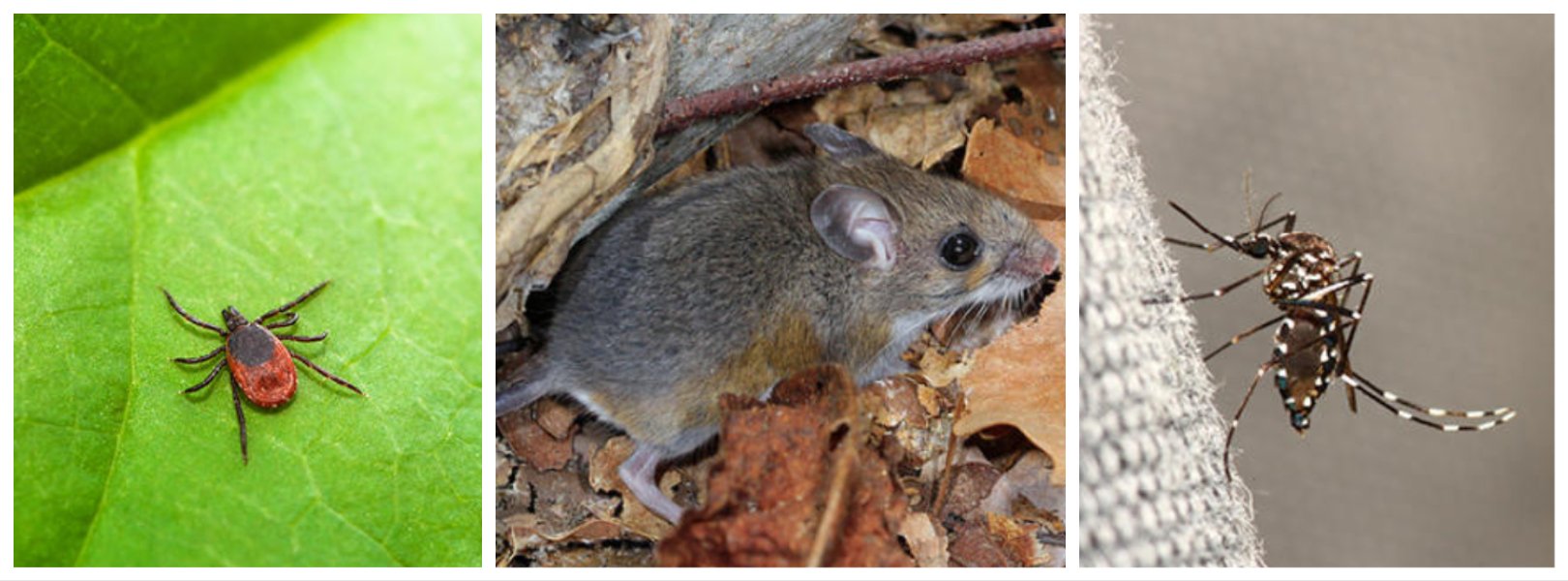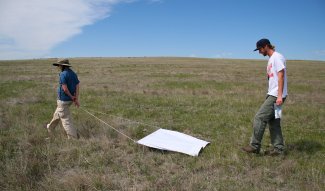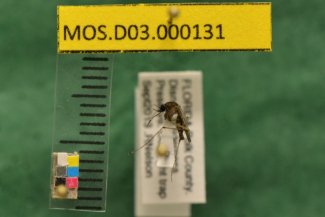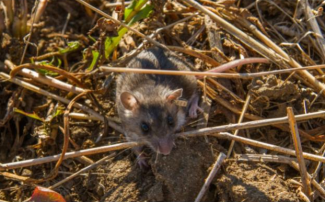Pathogens

Pathogens (microbial agents of disease), have large impacts on natural ecosystems as well as human populations and agricultural productivity. In recent decades, some pathogens carried by mosquitoes and ticks have emerged or re-emerged as significant public health concerns for both humans and livestock. Data on pathogen presence across many locations can be used to identify areas of the country where humans or livestock may be at heightened risk for vector-borne pathogens and predict how diseases may spread in the future.
NEON collects ticks, mosquitoes, and small mammals, and runs laboratory analyses to whether they carry certain types of pathogens. The data can provide important insights into pathogen spread, and also how pathogens as well as their hosts and vectors respond to changes in climate, land use, and ecosystem composition.
Pathogen testing
Pathogen testing is specific to each organism type and targets common diseases associated with each, including (but not limited to):
- Ticks: Lyme disease, Anaplasmosis, Monocytic Ehrlichiosis, Tularemia, Rocky Mountain Spotted Fever, Babesiosis
- Mosquitos: Including (but not limited to) West Nile virus, Dengue, Eastern Equine Encephalitis
- Rodents: Hantaviruses (2014—2019); Lyme disease, Anaplasmosis, Tularemia, Rocky Mountain Spotted Fever (2020 - present)
Tick-borne pathogen status

A tick drag being conducted at the Central Plains Experimental Research (CPER) field site.
Tick sampling is conducted at terrestrial field sites during the growing season. Once ticks have been identified by species, sex, and life stage, a subset of nymphal ticks are tested for the presence of bacterial and protozoan pathogens. Nymphs (immature ticks) are selected for testing because humans are most commonly infected by ticks in the nymph stage rather than the adult stage.
Six species of ticks are targeted for tick-borne pathogen testing: Ixodes scapularis (black-legged tick), I. pacificus (western black-legged tick), Amblyomma americanum (lone star tick), A. maculatum (Gulf Coast tick), Dermacentor andersoni (Rocky Mountain wood tick), and D. variabilis (American dog tick). A minimum of ten and a maximum of 100 nymphal ticks of each species are analyzed from each sampling event at each site. Ticks are tested individually for a wide range of pathogens including diseases caused by the genera Anaplasma (anaplasmosis), Borrelia (Lyme disease), Ehrlichia (monocytic ehrlichiosis), Francisella (tularemia), and Rickettsia (Rocky Mountain Spotted Fever).
Mosquito-borne pathogen status

Pinned mosquito sample of Mansonia titillans
Mosquitoes are collected at terrestrial field sites every two weeks (for core sites) or four weeks (for other sites) while temperatures are at or above 4°C (39.2°F) using CO2 light traps. A subset of female mosquitoes of the family Culicidae is screened for pathogens that can be transmitted to humans. Females are tested because only females bite and transmit diseases to humans.
Females are pooled by species for pathogen screening using PCR-based and/or Vero cell culture methods. This screening broadly tests for the presence of alphaviruses, bunyaviruses, and flaviviruses. Virus-positive pools are subjected to additional pathogen-specific tests to identify the pathogens that are present. Alphaviruses present in North America include several Equine Encephalitis species, which can cause disease in both humans and horses. The bunyaviridae family includes numerous viruses causing diseases in humans, including La Cross encephalitis and California encephalitis. Flaviviruses include West Nile, dengue, St. Louis encephalitis, and Zika.
Mosquitos in the genera Aedes and Culex are the primary vectors of diseases that impact humans, so species within these genera are given priority for screening. Other species are tested as resources and sample sizes allow. Mosquitos are tested in pools of 10 to 50 individuals grouped by species at the site level, with a target of 1,000 individual mosquitoes tested per species for each site each year (if available).

Field mouse at a NEON site
Rodent-borne Pathogen Status
Small mammal box trapping is conducted at regular intervals year-round at NEON terrestrial field sites. Blood and ear tissue samples are collected from individuals of target rodent species, including members of the rodent families Cricetidae, Muridae, and Dipodidae. Until 2020, a subset of blood samples was tested for seropositivity to hantaviruses, a family of rodent-borne viruses that cause varied diseases including Hantavirus Pulmonary Syndrome (HPS). Starting in 2020, rodent blood samples will be tested for tick-borne pathogens as described in the section above for tick-borne pathogen status. To increase the chances of detecting Borrelia burgdorferi, ear tissue samples will also be tested for these bacteria in all sites in domains where ticks have tested positive as well as the next closest domains to allow for emergence tracking. This pathogen is rarely found in the blood and is of significant public health concern.
Rodent species within the Peromyscus genera of the Cricetidae family are of special interest, particularly P. maniculatus (deer mouse) and P. leucopus (white-footed mouse). These species are broadly distributed, often present at high abundance, and are known reservoirs for a wide variety of tick-borne pathogens. Blood samples are collected from other rodent taxa that weigh at least 10 grams and are in good physical condition.
Approximately 70 blood samples will be tested per site per year. At sites that are candidates for Borrelia burgdorferi, 100 ear tissue samples will be tested per site per year.
Data Products
Tick-borne pathogen data and protocols may be found in the Tick-borne pathogen status (DP1.10092.001) data product. The initial field collection data and protocols may be found in the Ticks sampled using drag cloths (DP1.10093.001) data product.
Mosquito-borne pathogen data and protocols may be found in the Mosquito-borne pathogen status (DP1.10041.001) data product. The initial field collection data and protocols may be found in the Mosquitoes sampled from CO2 traps (DP1.10043.001) data product.
Rodent-borne pathogen data and protocols may be found in the Rodent-borne pathogen status (DP1.10064.001) data product. The initial field collection data and protocols may be found in the Small mammal box trapping (DP1.10072.001) data product.
Archival Samples
Mosquito-borne pathogens
Mosquito specimens are archived at the NEON Biorepository. Mosquitoes are collected at terrestrial sites by NEON staff and identified by contracted taxonomists. Select mosquitoes are tested for pathogens; after pathogen analysis, any remaining genomic extract from mosquito pools are archived. Any mosquitoes that are not assayed for pathogens are either archived in groups of individuals of the same species and sex collected during the same collection bout or archived as individual voucher specimens. A subset of identified mosquitoes (up to 20 individuals of each species) are mounted on points as vouchers. Genetic analysis (DNA barcoding) is performed on some of these vouchers; any surplus genomic extracts from this analysis are also archived.
| Types of Samples | Storage Condition | Storage Container | Quantity Archived (Annually) † | Link to the Collection |
|---|---|---|---|---|
| Genomic extracts, from pathogen testing | -80°C | 2 mL cryovials | 4,500 to 7,500 extracts | Mosquito Collection (Pathogen Extracts) (NEON-MOSC-PE) |
| Identified Mosquitoes, bulk | -80°C | 2-15mL cryovials | 2,500 to 3,600 pools | Mosquito Collection (Bulk Identified) (NEON-MOSC-BI) |
| Identified Mosquitoes, vouchers | dry | individuals mounted on points | 2,000 to 2,400 individuals | Mosquito Collection (Pinned Vouchers) (NEON-MOSC-PV) |
| DNA extracts from vouchered mosquitoes | -80°C | 96-well plates‡ | 1,850 to 1,950 extracts | Mosquito Collection (DNA Extracts) (NEON-MOSC-DNA) |
Tick-borne pathogens
Tick specimens are archived at the NEON Biorepository and the US National Tick Collection (located in Statesboro, GA at Georgia Southern University). Ticks are collected at terrestrial sites by NEON staff and identified by contracted taxonomists. Select ticks are tested for pathogens; after pathogen analysis, any remaining genomic extract from individual ticks are archived. Any ticks that are not assayed for pathogens are archived in groups of individuals of the same species and sex collected during the same collection bout.
| Types of Samples | Storage Condition | Storage Container | Quantity Archived (Annually) † | Archive Location |
|---|---|---|---|---|
| Genomic extracts, from pathogen testing | -80°C | 2 mL cryovials | 3,000 to 4,000 extracts | Tick Collection (DNA Extracts [Pathogen Extracts]) (NEON-TICC-PE) |
| Identified Ticks, bulk | 95% ethanol | 2-15mL vials | US National Tick Collection |
Rodent-borne pathogens
Both whole specimen and tissue samples are available for use from the NEON Biorepository. Samples may include preserved whole specimens (for trait analysis), ear punches, hair and whisker samples, biological tissues (skin, organs) and feces. Some samples are available for destructive purposes and others for non-destructive research purposes only. NEON also archives small mammal DNA extractions.
| Types of Samples* | Storage Condition | Storage Container | Quantity Archived (Annually) † | Link to the Collection |
|---|---|---|---|---|
| Blood samples | -196°C | 2 mL cryovials | 1,600 to 2,100 vials | Mammal Collection (Blood Samples) (NEON-MAMC-BL) |
| Ear tissue | -196°C | 2 mL cryovials | 450 to 550 samples | Mammal Collection (Ear Tissue) (NEON-MAMC-EA) |
| Genomic extracts, from pathogen testing | -196°C | 2 mL cryovials | 500 to 5,475 vials | Mammal Collection (Pathogen Extracts [Ear Tissue]) (NEON-MAMC-PEEA) and Mammal Collection (Pathogen Extracts [Blood]) (NEON-MAMC-PEBL) |
| DNA extracts from ear tissue | -80°C | 96-well plates‡ | 1,850 to 1,950 extracts | Mammal Collection (DNA Extracts) (NEON-MAMC-DNA) |
| Fecal samples | -196°C | 2 mL cryovials | 4,500 to 9,600 samples | Mammal Collection (Fecal Samples) (NEON-MAMC-FE) |
| Hair and Whiskers | dry | archival coin envelopes | 3,200 to 5,800 samples | Mammal Collection (Hair Samples) (NEON-MAMC-HA) |
| Small mammals, whole vouchers | Frozen dry or 95% ethanol | individual or lots | 600 to 900 individuals | Mammal Collection (Vouchers [Standard Sampling at Pathogen Plots]) (NEON-MAMC-VPP) |
* Select specimens collected from 2013-2017 and most specimens collected after 2018 are archived at the NEON Biorepository. See table below for information about the archive locations of early (2013-2017) material.
† Quantities represented in this table are annual quantities expected from sampling conducted throughout the observatory during full Operations. Actual quantities may differ from these projections
‡ Quantities are number of samples (not number of well plates); up to 96 samples are contained on the same well plate